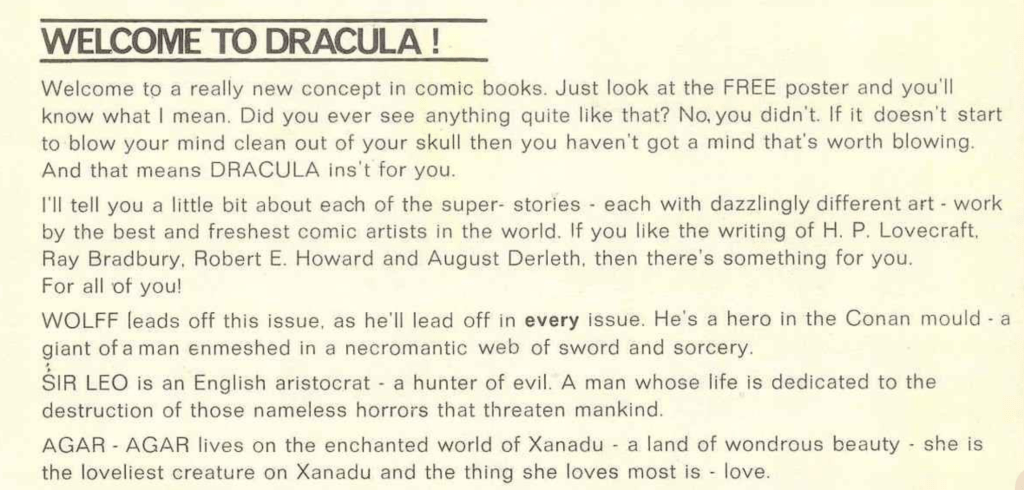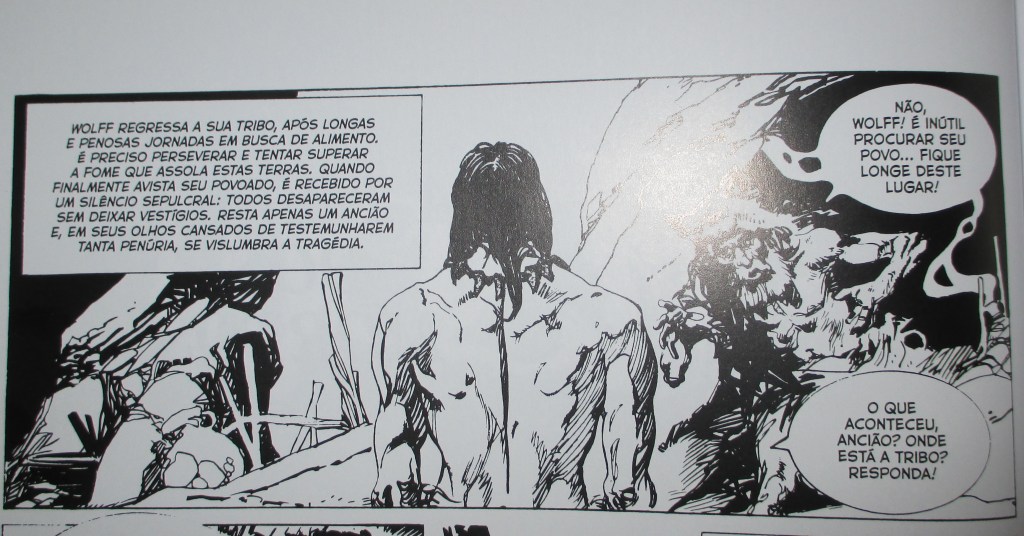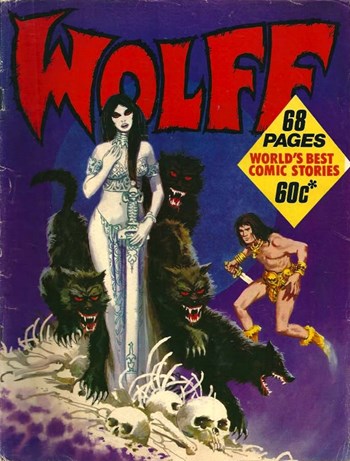| Luis Vigil, que ne época fazia a revista Nueva Dimensión, tinha me mostrado algumas capas norte-americanas de um gênero resgatado sa antigas pulps estadunidenses: Espada & Feitiçaria. Essas capas eram maravilhosas. Em uma, um guerreiro selvagem protegia uma donzela seminua, rodeados por um conjunto de figuras misteriosas, caveiras, bruxos, fortalezas, dragões… Tudo apenas insinuado. Em outra, o guerreiro montado nas costas de uma gigantesca serpente, com diversas caveiras e outras formas monstruousas, preso em um calabouço. Elas raziam todos os elementos que eu sempre amei. Perguntei a Luis se havia alguma tradução daquelas histórias para o espanhol e ele respondeu que não (anos mais tarde, a editora Bruguera a publicaria). O protagonista das imagens se chamava Conan e o ilustrador era Frank Frazetta. Quando em, 1969, Luis Gasca me pediu idias para uma história que seria publicada em uma nova revista, props um personagem daquele estilo. Ele aprovou, e assim nasceu Wolff, para a revista Drácula. Eu desenhava o que queria, fazia uma pequena sinopse e ele escrevia os textos finais com a pseudônimo Sadko. Mese depois, começaram a publicar nos Estados Unidos a adaptação do personagem de Robert E. Howard, Conan, no clássico formato dos comics, na revista Savage Tales, da Marvel, com desenhos de Barry WIndosr-Smith e roteiros de Roy Thomas. | Luis Vigil, who at the time was at Nueva Dimensión magazine, had shown me some North American covers of a genre rescued from the old American pulps: Sword & Sorcery. Those covers were marvelous. In one, a wild warrior protected a half-naked maiden, surrounded by an array of mysterious figures, skulls, witches, fortresses, dragons… All just hinted at. In another, the warrior riding on the back of a gigantic serpent, with several skulls and other monstrous shapes, trapped in a dungeon. They brought out all the elements that I’ve always loved. I asked Luis if there was any translation of those stories into Spanish and he answered no (years later, Bruguera publishing house would publish it). The protagonist of the images was called Conan and the illustrator was Frank Frazetta. When, in 1969, Luis Gasca asked me for ideas for a story to be published in a new magazine, I proposed a character in that style. He approved, and thus Wolff was born, for Drácula magazine. I would draw what I wanted, make a short synopsis, and he would write the final texts under the pseudonym Sadko. Months later, they began publishing in the United States the adaptation of Robert E. Howard’s character Conan in the classic comic book format in Marvel’s Savage Tales magazine, with drawings by Barry Windsor-Smith and scripts by Roy Thomas. |
| Esteban Maroto, Espadas e Bruxas (2017) 10 | English translation |
In 1971, Spanish publisher Buru Lan published began publishing Drácula, which despite the name had little to do with Bram Stoker’s character, but was a general fantasy and horror comic comparable in some ways to Warren Comics’ Eerie and Creepy in the United States—especially since Warren would, at about the same time as Drácula came out, begin relying heavily on Spanish artists such as Esteban Maroto. At the same time, the paperback fantasy boom in the United States was blossoming with the Lancer editions of Robert E. Howard’s Conan, with covers by Frank Frazetta (who also lent his talents to Warren magazines).

Marvel’s Conan the Barbarian comic by Roy Thomas and Barry Windsor-Smith first hit the stands in 1970, and its success helped to spread the fantasy boom to comic books. It was a good time to build your own barbarian…and so, Gusca and Maroto created Wolff, inspired by and in the mold of Conan (or at least, Frazetta’s covers for the Conan paperbacks). The series caught the eye of English-language publishers, and the British publisher New English Library translated and published twelve issues under the title Dracula; Warren combined several issues as a standalone graphic novel, also titled simply Dracula…implicitly competing with Dracula Lives! and Savage Tales, both produced by Curtis, Marvel’s magazine imprint. Full-size comic magazines could circumvent the restrictions on nudity and content imposed by the Comics Code Authority on comic books.
One gets the impression the English publishers of Dracula understood exactly what they were doing; in the intro to the first issue of Dracula, the editors wrote:

The Wolff comics themselves would seem to reinforce these arguments, since Wolff is happy to swear by Crom, Mitra, and Set and throw in other references to Howard’s Conan stories and Lovecraftian allusions. All of which are, in hindsight, a bit odd if Maroto claimed they hadn’t been translated yet.

What happened is that Gusca’s script was changed in the translation. Compare this same scene to that in the 2017 Brazilian Portuguese translation, which is closer to the original Spanish:

The uncredited translator obviously took a few liberties in order to emphasize the connections between Wolff and Conan, inserting the occasional “By Crom!” or whatnot wherever convenient. Whatever injustice was done to Luis Gusca’s script, however, was balanced by accurate reproduction of Maroto’s artwork, especially in the 1973 trade paperback edition, which is larger than the average magazine page size and on glossy paper rather than newsprint.
From the description Maroto gives, he and Gusca appear to have used something similar to the Marvel Method—and the evidence of Maroto’s freed is clear in nearly every page and panel; while more restrained than the other blatantly psychedelic stories in Dracula, Maroto’s backgrounds are often sparse, but with well-proportioned, realistic figures and phantasmagoric tableaux.

Wolff’s adventures follow a series of interlinked quests. Unlike Howard’s Conan stories, the plots tend to be rather straightforward, with few betrayals or moral complexities to vex the hero; but there is much of wonder and horror. This was before Conan had become widely-parodied as a simple musclebound brute, and Wolff often overcomes the challenges set regularly in his path by luck and cunning as much as brute strength or swordplay. Wolff is obviously inspired by Conan, right down to the visual details, but he is not Conan; there is none of the brooding and cynicism that mark Howard’s hardboiled fantasy.
In terms of fantasy comics of the 1970s, “Wolff” is sadly little more than a footnote, much like Dagar the Invincible (Gold Key, 1972-1976) by Don E. Glut and Jesse Santos, or Maroto’s other barbarian Dax the Warrior for Warren’s Eerie (based on his Spanish comic “Manly”), and remembered today largely for Maroto’s artwork than for the stories themselves. These were the barbarians inspired by Conan, both as Robert E. Howard wrote him, and increasingly as Conan was depicted in the artwork and adaptations created by folks like Frank Frazetta, Roy Thomas, and Barry Windsor-Smith.
Aside from translation issues, the full series was only ever collected in English in a scarce Australian edition printed on newsprint in black and white:
So, most collectors would have to hunt down the original issues if they want to see what Wolff’s later adventures were. In other markets, a resurgence of interest in Esteban Maroto’s art have led to reprints like Espadas e Bruxas, but most English-speaking readers who want to admire Maroto’s work will have to content themselves with volumes like Lovecraft: The Myth of Cthulhu (2018).
Bobby Derie is the author of Weird Talers: Essays on Robert E. Howard & Others (2019) and Sex and the Cthulhu Mythos (2014).
Deep Cuts in a Lovecraftian Vein uses Amazon Associate links. As an Amazon Associate I earn from qualifying purchases.
